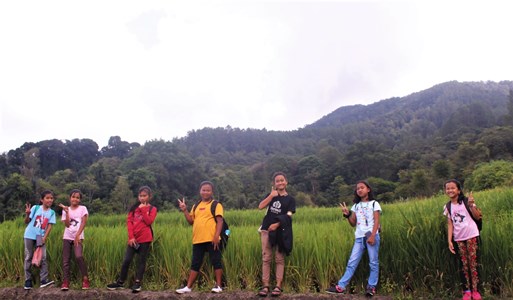Simalungun, NINNA.ID-Di Kawasan Danau Toba, tepatnya di Kampung Girsang yang dikenal orang dengan sebutan Girsang 1 dan Girsang 2, alam dan budaya saling berpelukan erat. Hijaunya sawah, aroma rempah dari hutan tropis, dan kokohnya Rumah Batak yang berumur ratusan tahun.
Semuanya menyatu membentuk simfoni kehidupan yang menenangkan hati dan menyejukkan mata. Inilah sekelumit dari keajaiban yang kami promosikan dalam upaya mendukung Danau Toba sebagai bagian dari jaringan Taman Bumi Dunia.
Bukit Simumbang: Menyapa Langit, Menyelami Hutan
Langkah kami terhenti sejenak di sebuah pondok sederhana di lereng Bukit Simumbang. Aplikasi My Elevation menunjukkan angka 1.196 meter di atas permukaan laut.

Dari titik ini, mata kami disuguhkan panorama menakjubkan: Danau Toba yang luas berkilau di kejauhan dan kota Parapat yang terhampar seperti miniatur.
Namun, keindahan itu bukan satu-satunya yang ditawarkan bukit ini. Perjalanan ke Simumbang adalah petualangan spiritual—melintasi ladang-ladang yang ditanami padi, kopi, coklat, dan berbagai tanaman obat yang telah diwariskan secara turun-temurun.
Di sini, hutan bukan hanya sumber oksigen, tapi juga apotek alami yang menyelamatkan warga selama pandemi. Jahe, kunyit, dan lengkuas menjadi andalan penguat daya tahan tubuh.
Menyusuri hutan ini, kami juga disambut suara alam: denting air sungai tadah hujan dan nyanyian burung Enggang dari kejauhan. Jika beruntung, kita bisa melihat Imbo (Siamang), beruang madu, atau binatang hutan lainnya yang masih setia menjaga rahasia Lembah dan Bukit.
Sitombom: Mosaik Hijau di Kaki Bukit
Di bawah Bukit Simumbang terbentang Sitombom, lembah kecil yang menjadi saksi gigihnya para petani Kampung Girsang . Nama "tombom" berarti jatuh, sesuai letaknya yang tersembunyi di kaki bukit.

Tapi justru dari lembah inilah, kita melihat keindahan yang tak bisa ditolak: teras-teras sawah yang mengalir mengikuti kontur tanah, membentuk lukisan hidup dalam gradasi warna hijau.
Para petani di sini adalah seniman alam. Mereka menciptakan sistem pengairan dari sungai pegunungan dan menyulap tebing menjadi ladang padi.
Ini bukan hanya soal bertani—ini soal mempertahankan warisan, budaya kerja keras, dan filosofi "marsiadapari", gotong royong yang masih hidup hingga kini.
Mak Ober, salah satu petani senior, tampak berdiri memandangi padinya. Ia sedang menimbang, apakah panen sudah waktunya atau harus menunggu sinar matahari beberapa hari lagi.
Ketika kami bertanya, ia hanya tersenyum dan menunjuk langit. “Tanda-tandanya ada di sana,” katanya bijak.
Sigala-Gala: Di Antara Teras Sawah dan Semilir Angin
Nama Sigala-Gala diambil dari jenis tanaman yang mendominasi wilayah ini. Tempat ini adalah jalan penghubung antara Girsang 1 dan Girsang 2, serta pintu gerbang menuju air terjun yang tersembunyi.
Di sinilah pengunjung bisa berjalan di antara hamparan sawah, menghirup udara segar, dan menyaksikan petani bekerja dengan alat-alat tradisional: cangkul, parang, dan semangat tak tergoyahkan.
Perjalanan menuju Sigala-Gala mengajak kita menelusuri huta-huta yang masih mempertahankan Rumah Batak asli. Jalan bercabang ke kiri membawa kita ke Huta Simandalahi, sementara ke kanan menuju panorama sawah yang seolah tak berujung.
Terutama saat musim panen, warna-warna kuning keemasan dan hijau zamrud berpadu menciptakan keindahan yang nyaris tak tergambarkan.
Huta Simandalahi: Rumah-Rumah yang Bercerita
Di balik pepohonan dan ladang, berdirilah Huta Simandalahi. Kampung tua ini didirikan oleh keturunan Simandalahi bermarga Sinaga. Meski banyak keturunannya kini merantau, rumah-rumah Batak di sini tetap berdiri kokoh.
Dibangun tanpa paku, rumah-rumah ini menampung hingga 6 keluarga pada masa lampau, dan tetap jadi simbol keuletan dan arsitektur tradisional.
Di Kampung Girsang, bertani bukan sekadar profesi—ia adalah budaya dan filosofi hidup. Anak-anak sudah akrab dengan parang sejak kecil. Mereka diajarkan menanam, merawat, hingga memanen.
Proses panjang ini menjadi guru kehidupan, mengajarkan ketekunan dan keberanian. Bahkan ketika berhadapan dengan ular atau binatang berbisa, anak-anak desa ini tetap tenang dan terus melangkah. Mereka tidak hanya tumbuh bersama alam, mereka adalah bagian dari alam itu sendiri.
Girsang Kreatif
Potensi Kampung Girsang tak berhenti pada keindahan alam. Warganya aktif mengelola hasil pertanian menjadi komoditas unggulan.
Kopi, kakao, kemiri, jahe, hingga andaliman—semuanya dipasarkan secara langsung ke warung, pasar, bahkan wisatawan.
Beberapa warga sudah mulai mengolah hasil bumi menjadi produk siap saji seperti kue, kopi bubuk, dan masakan tradisional.
Kampung Girsang adalah napas segar di tengah geliat modernisasi. Ia tak hanya menampilkan lanskap memikat, tapi juga cerita-cerita kecil yang menggugah.
Dari Bukit Simumbang yang menyentuh awan, hingga senyuman hangat petani di tengah ladang, setiap sudut Kampung Girsang memanggil kita untuk datang, belajar, dan biarkan hatimu tinggal di Kampung Girsang.
Penulis/Editor: Damayanti Sinaga













